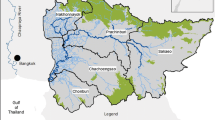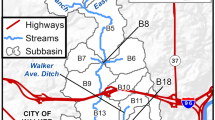Abstract
This paper is aimed at developing a systematic and generally applicable methodology for material flow analysis in drainage systems and watersheds. In particular, this research has focused on developing a mathematical framework and application for the management of nitrogenous species (primarily ammonium ions). Nitrogen compounds are among the most important species contributing to ecological cycles. Indeed, the environmental and biological aspects of water systems and their surrounding systems are highly impacted by nitrogen compounds as they contribute to the quality, nutrition, and toxicity of these systems. A material flow model was developed to deal primarily with the water phase while including pertinent information on the solid and air phases as they interface with the water medium. Both spatial and discrete temporal dimensions were included to account for nitrogen flow and transformation. The model includes the various environmental phenomena that influence the fate and transport of targeted species (e.g., volatilization, precipitation, sedimentation, uptake by biota, adsorption, chemical and biochemical reactions, etc.). Furthermore, the model includes material flow analysis operators (or transfer functions) that characterize the system inputs and outputs as they relate to the surroundings. The aforementioned material flow analysis tools were combined in a computer-aided modeling platform to provide a complete material flow analysis and yield useful insights on the transport and fate of targeted species. The simulation results shed light on the system performance. Actual data for an Egyptian drainage system (Bahr El-Baqar) along with the outfall to Lake Manzala were used to illustrate the usefulness and applicability of the developed model. Comparison with the measured data confirmed the validity and fidelity of the model.
















Similar content being viewed by others
References
Baccini P, Brunner P (1991) Metabolism of the Anthroposphere. Springer-Verlag, Berlin Heidelberg New York
Barakat AO (2003) Assessment of Persistent Toxic Substances in the Environment of Egypt. Environment International 9: 181–195
Cooper AB (1986) Developing Management Guideline for River Nitrogenous Oxygen Demand. Journal of Water Pollution Control Federation 58(8): 845–878
Cooper AB (1984) Activities of Benthic Nitrification in Streams and Their Role in Oxygen Consumption. Microb. Ecol. 10: 317–334.
Drolc A, Zagorc J, Cotman M (2001) Evaluation of Total Nitrogen Pollution Reduction Strategies in a River Basin: A Case Study. Water Science and Technology 44(6): 55–62
El-Halwagi, MM (2003) Industry and Environmental Biocomplexity: Impact, Challenges, and Opportunities for Multidisciplinary Research. J. Clean Technologies and Environmental Policy 4(3): 135
El Sayed A (1994) The Effect of Wastewater Discharge on the Water Quality of Bahr El-Baqar Drain. M.Sc. Thesis, Cairo University, Egypt
Hall GH (1986) Nitrification. In: Prosser JI (ed) Special Publication of the Society for General Microbiology, vol. 20. IRL Press, Oxford pp 127–156.
Lampert Ch, Brunner PH, (1999) Material Accounting as a Policy Tool for Nutrient Management in the Danub Basine Water. Science and Technology 40(10): 43–49
Matulewich VA, Strom PF, Finstein MS, (1978) Distribution of Autotrophic Nitrifying Bacteria in a Polluted River. Appl. Environ. Microbiol. 35: 67–71
Obernosterer R, Brunner PH, Daxbeck H, Glenck E, Hendriks C, Morf L. (1998) Material Accounting as a Tool for Decision Making in Environmental Policy: A Case Study Report; Urban Metabolism. Institute for Water Quality and Waste Management, Technical University of Vienna, Vienna
Pauer J, Auer M (2000) Nitrification in the Water Column and Sediment of a Hypereutrophic Lake and Adjoining River System. Wat. Res. 34(4): 1247–1254
Shallcross AL, Mercer GW, Macaitis W (1993) Understanding Nitrogen Dynamics of the Chicago and Upper Illinois Waterways System through Water Quality Modeling. Water Environment Federation 66th Annual Conference, Anaheim, CA
Sharma B, Ahlert RC (1977) Nitrification and Nitrogen Removal. Water Research 11: 897–925
Schultz W (2001) Biocomplexity for Chemists. Chemical and Engineering News 79 (2): 19–20
Siegel FR (1995) Environmental Geochemistry in Development Planning: An Example from the Nile delta, Egypt. J. Geochemical Exploration 55(1–3): 265–273
SOGREAH Consulting Engineers (1995) Technical Report, East Bank Stage 2. The Organization for Executing of greater Cairo Wastewater Project. SOGREAH Publications, Cairo, Egypt
Stewart J (1992) Policy Analysis and Development for Liquid Waste Management in Rural Egypt. Ph.D. Dissertation, Department of Civil Engineering and Environmental Health, University of Strathclyde, Glasgow, The United Kingdom
Thoman RV, Muller JA (1989)Principles of Surface Water Quality and Control. Harper Collins, New York
Veselic M, Pintar M, Drolc A, Vizintin G, Cencur-Curk B, Ros M Zagorc-Koncan J (2001) River Basin Water Nitrate Quality Management with Respect to the Existing Data Structures. In: Falconer RA, Blain WR (eds) River Basin Management. WIT, Southampton, pp 359–371
Welch EB (1992) Ecological Effects of Wastewater. Applied Limnology and Pollutant Effects, 2nd edn. Chapman and Hall, London
Acknowledgements
The authors gratefully acknowledge the financial support of the NSF (project # OISE-0413170) and Zagazig University.
Author information
Authors and Affiliations
Corresponding author
Rights and permissions
About this article
Cite this article
El-Baz, A.A., Ewida, M.K.T., Shouman, M.A. et al. Material flow analysis and integration of watersheds and drainage systems: I. Simulation and application to ammonium management in Bahr El-Baqar drainage system. Clean Techn Environ Policy 7, 51–61 (2004). https://doi.org/10.1007/s10098-004-0258-7
Received:
Accepted:
Published:
Issue Date:
DOI: https://doi.org/10.1007/s10098-004-0258-7




